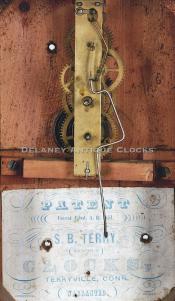Silas B. Terry, Terryville, Conn., miniature shelf clock with 30 hour ladder time only, movement in a decorative paper covered case. TT-169.
This form is called a “Cottage Clock.” What is unusual about this example is that the case is veneered with a paper product or decoration. This example features a linear repetitive pattern. The condition of this veneer is excellent. We have seen several examples of this case form. Variations in the pattern are somewhat common. This veneered example must have been a more expensive option than the version finished in natural wood color. The upper and lower moldings are canted in towards the main body of the case. The entire front of this clock doubles as a door. Both panels are fitted with glass. The lower tablet features a lovely acid-etched design that is in excellent condition. The scene depicts an American eagle with outstretched wings. Olive branches and arrows are clutched in its claws. This is a patriotic depiction. The door opens to allow one access to the interior of the case. It swings to the right on a pair of brass pin hinges. The dial is painted on tin. It features a Roman numeral time ring. The original brass-made hands tell the time. Note the unusual location of the winding arbor. This indicates to the astute collector that this clock has S.B.’s Ladder type movement. If you remove the dial, you will see that this version features vertically positioned gearing, and the time spring is mounted on the outside of the back plate. It is key wound and designed for 30 hours on a full wind. Pasted inside the case onto the backboard is the Maker’s label. This label is in very good original condition and features blueprinting.
This clock measures approximately 10.25 inches tall. It was made circa 1850.
Inventory number TT-169.
Silas B. Terry was born on February 1, 1807 (during Eli's involvement with the porter contract) and died of a heart attack on May 20, 1876. He was the youngest of eight children born to Eli & Eunice (Warner) Terry. Silas worked in various clockmaking enterprises. Unlike his father, he focused on the more expensive brass-geared clocks and was in the process of producing them as early as December of 1833. He was an inventive person and was constantly testing new designs. One of the most notable was the application of the balance wheel to clock movements. Silas was granted a patent for this on August 9, 1845. Silas was involved with several clockmaking firms, which included the S. B. Terry & Company (1852-1853) and Terryville MFG., Co. (1853-1854). In 1854, Terry went bankrupt and took a job as a general manager of the William L. Gilbert & Company of Winsted, Connecticut. In 1861, he took a job as superintendent of the Waterbury Clock Company. In 1867, he formed the Terry Clock Company in Waterbury with his sons. Silas' early clocks were well made and often had interesting movements. The evidence of his work supports the suggestion that he loved to tinker.






